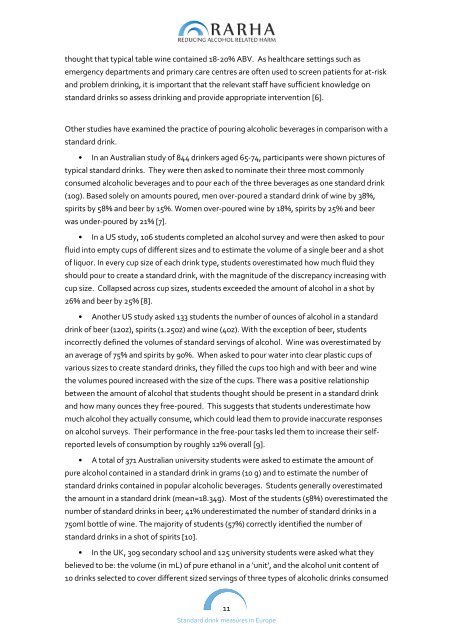Standard drink measures in Europe
WP5%20Background%20paper%20Standard%20drink%20measures%20HRB
WP5%20Background%20paper%20Standard%20drink%20measures%20HRB
You also want an ePaper? Increase the reach of your titles
YUMPU automatically turns print PDFs into web optimized ePapers that Google loves.
thought that typical table w<strong>in</strong>e conta<strong>in</strong>ed 18-20% ABV. As healthcare sett<strong>in</strong>gs such as<br />
emergency departments and primary care centres are often used to screen patients for at-risk<br />
and problem <strong>dr<strong>in</strong>k</strong><strong>in</strong>g, it is important that the relevant staff have sufficient knowledge on<br />
standard <strong>dr<strong>in</strong>k</strong>s so assess <strong>dr<strong>in</strong>k</strong><strong>in</strong>g and provide appropriate <strong>in</strong>tervention [6].<br />
Other studies have exam<strong>in</strong>ed the practice of pour<strong>in</strong>g alcoholic beverages <strong>in</strong> comparison with a<br />
standard <strong>dr<strong>in</strong>k</strong>.<br />
• In an Australian study of 844 <strong>dr<strong>in</strong>k</strong>ers aged 65-74, participants were shown pictures of<br />
typical standard <strong>dr<strong>in</strong>k</strong>s. They were then asked to nom<strong>in</strong>ate their three most commonly<br />
consumed alcoholic beverages and to pour each of the three beverages as one standard <strong>dr<strong>in</strong>k</strong><br />
(10g). Based solely on amounts poured, men over-poured a standard <strong>dr<strong>in</strong>k</strong> of w<strong>in</strong>e by 38%,<br />
spirits by 58% and beer by 15%. Women over-poured w<strong>in</strong>e by 18%, spirits by 25% and beer<br />
was under-poured by 21% [7].<br />
• In a US study, 106 students completed an alcohol survey and were then asked to pour<br />
fluid <strong>in</strong>to empty cups of different sizes and to estimate the volume of a s<strong>in</strong>gle beer and a shot<br />
of liquor. In every cup size of each <strong>dr<strong>in</strong>k</strong> type, students overestimated how much fluid they<br />
should pour to create a standard <strong>dr<strong>in</strong>k</strong>, with the magnitude of the discrepancy <strong>in</strong>creas<strong>in</strong>g with<br />
cup size. Collapsed across cup sizes, students exceeded the amount of alcohol <strong>in</strong> a shot by<br />
26% and beer by 25% [8].<br />
• Another US study asked 133 students the number of ounces of alcohol <strong>in</strong> a standard<br />
<strong>dr<strong>in</strong>k</strong> of beer (12oz), spirits (1.25oz) and w<strong>in</strong>e (4oz). With the exception of beer, students<br />
<strong>in</strong>correctly def<strong>in</strong>ed the volumes of standard serv<strong>in</strong>gs of alcohol. W<strong>in</strong>e was overestimated by<br />
an average of 75% and spirits by 90%. When asked to pour water <strong>in</strong>to clear plastic cups of<br />
various sizes to create standard <strong>dr<strong>in</strong>k</strong>s, they filled the cups too high and with beer and w<strong>in</strong>e<br />
the volumes poured <strong>in</strong>creased with the size of the cups. There was a positive relationship<br />
between the amount of alcohol that students thought should be present <strong>in</strong> a standard <strong>dr<strong>in</strong>k</strong><br />
and how many ounces they free-poured. This suggests that students underestimate how<br />
much alcohol they actually consume, which could lead them to provide <strong>in</strong>accurate responses<br />
on alcohol surveys. Their performance <strong>in</strong> the free-pour tasks led them to <strong>in</strong>crease their selfreported<br />
levels of consumption by roughly 12% overall [9].<br />
• A total of 371 Australian university students were asked to estimate the amount of<br />
pure alcohol conta<strong>in</strong>ed <strong>in</strong> a standard <strong>dr<strong>in</strong>k</strong> <strong>in</strong> grams (10 g) and to estimate the number of<br />
standard <strong>dr<strong>in</strong>k</strong>s conta<strong>in</strong>ed <strong>in</strong> popular alcoholic beverages. Students generally overestimated<br />
the amount <strong>in</strong> a standard <strong>dr<strong>in</strong>k</strong> (mean=18.34g). Most of the students (58%) overestimated the<br />
number of standard <strong>dr<strong>in</strong>k</strong>s <strong>in</strong> beer; 41% underestimated the number of standard <strong>dr<strong>in</strong>k</strong>s <strong>in</strong> a<br />
750ml bottle of w<strong>in</strong>e. The majority of students (57%) correctly identified the number of<br />
standard <strong>dr<strong>in</strong>k</strong>s <strong>in</strong> a shot of spirits [10].<br />
• In the UK, 309 secondary school and 125 university students were asked what they<br />
believed to be: the volume (<strong>in</strong> mL) of pure ethanol <strong>in</strong> a ‘unit’, and the alcohol unit content of<br />
10 <strong>dr<strong>in</strong>k</strong>s selected to cover different sized serv<strong>in</strong>gs of three types of alcoholic <strong>dr<strong>in</strong>k</strong>s consumed<br />
11<br />
<strong>Standard</strong> <strong>dr<strong>in</strong>k</strong> <strong>measures</strong> <strong>in</strong> <strong>Europe</strong>


